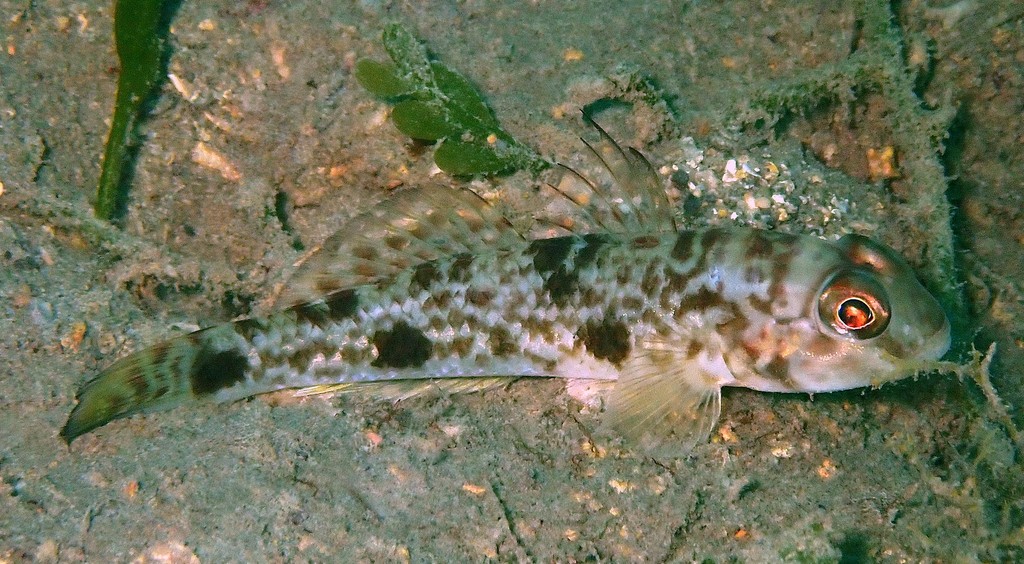YONGEICHTHYS NEBULOSUS - (FORSSKAL, 1775)
Picture courtesy of: Alain Daoulas
Gobie obscure, Hair-finned goby, Hairfin goby, Poisonous goby, Shadow goby, Three-blotch goby, Skaduwee-dikkop, Tsumugihaze, ツムギハゼ, 云纹鰕虎, 雲紋鰕虎, 云纹裸颊鰕虎鱼,
Synonymes
Acentrogobius criniger (Valenciennes, 1837)
Acentrogobius nebulosus (Forsskal, 1775)
Ctenogobius criniger (Valenciennes, 1837)
Ctenogobius nebulosus (Forsskal, 1775)
Ctenogobius petersenii (Steindachner, 1866)
Gobius auchenotaenia (Bleeker, 1867)
Gobius brevifilis (Valenciennes, 1837)
Gobius caninus africana (Playfair, 1867)
Gobius caninus africanus (Playfair, 1867)
Gobius criniger (Valenciennes, 1837)
Gobius festivus (De Vis, 1884)
Gobius nebulosus (Forsskal, 1775)
Gobius petersii (Steindachner, 1866)
Rhinogobius criniger (Valenciennes, 1837)
Rhinogobius lungi (Jordan & Seale, 1907)
Rhinogobius nebulosus (Forsskal, 1775)
Yongeichthys criniger (Valenciennes, 1837)
--------------------------
Description
Dorsal spines (total): 7; Dorsal soft rays (total): 8-10 (usually: 9); Anal spine: 1; Anal soft rays: 9-10; Pectoral fin rays: 18-19; Longitudinal scale series: 26-33; Scales on body ctenoid except abdomen and prepelvic area where cycloid; No scales on head (cheek and opercle) or nape except for a few ventrally on nape extending a short distance anterior to gill opening; Gill opening ending at level of lower edge of pectoral fin base; Transverse rows of scales backwards: 10-12; Body depth: 4.2-4.8 in SL; Head length: 3.2-3.4 in SL; Several longitudinal rows of papillae on cheek; Longitudinal papillae on cheek in 7-9 rows, and papillae rows may be multiple. Elongate and filamentous second and third dorsal spines: 3.4-4.0 in SL; Caudal fin rounded, a little shorter than head length; Pelvic fin united; Pelvic frenum present. Max. length: 12.3 cm SL. Depth range: 1 - 30 m, usually: 1 - 15 m.
Color
Head and body whitish to pale brownish grey, with yellowish brown to brownish fine speckling and indistinct mottled lines along back and sides; most distinctive markings are 3 large brown rounded blotches along midsides of body, with last blotch on caudal-fin base; Two broad diffuse brownish bars from edge of eye across jaw and cheek; Dorsal fin spines blackish.
Etymology
Yongeichthys: in honnor of Sir Charles Maurice Yonge (1899-1986) who was an English marine zoologist. He was also the leader of the Great Barrier Reef Expedition (1928-1929) + from Greek, ichthys = fish.
nebulosus: from Latin, nebula = cloud + from Latin suffix, -osus = misty, foggy, clouded, obscure. Referring to its rough, dark-cloudy (“fusco-nebulosis”) scales.
Original description: Gobius nebulosus Forsskål, 1775 - Type locality: Jeddah, Saudi Arabia, Red Sea.
Distribution
Red Sea; Indo-West Pacific: South Africa, East Africa and Madagascar, east to Society Islands (French Polynesia), north to Kagoshima Prefecture (southern Japan), south to Western Australia, Queensland (Australia) and New Caledonia.
Biology
Solitary. Found over silty and muddy bottoms around inner reefs. Common in mangroves and enter estuaries and rivers. Toxin concentrated in the skin. Contains 28.7 µg/g tetrodotoxin in the internal organs while the flesh holds 1.7 µg/g. Poisonous to eat.
Last update: 16, May 2023
